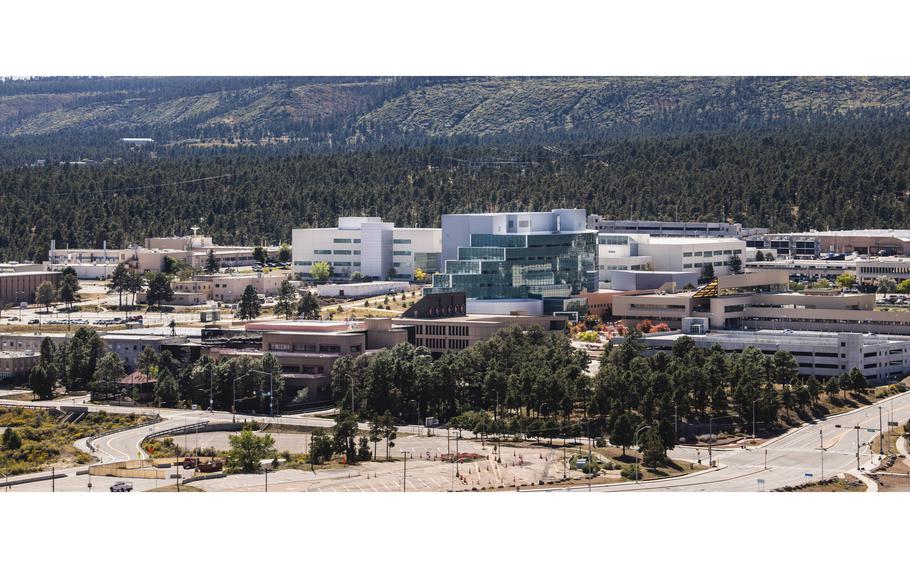
Los Alamos National Laboratory in 2019. (Kevin Sutton/Los Alamos National Laboratory)
(Tribune News Service) — Estimates for costs and the time required to produce nuclear bomb cores, including 30 per year at Los Alamos National Laboratory, are severely lacking and could make it difficult for federal managers to avoid cost overruns, delays and other problems, a government watchdog said in a report released Thursday.
The plan for the lab and the Savannah River Site in South Carolina to produce a combined 80 nuclear warhead triggers, or "pits," each year by 2035 is a massive, complex undertaking that demands detailed scheduling, a careful accounting of costs and clear estimates of how long various tasks will take — none of which are being done by the federal agency in charge of nuclear weapons, the Government Accountability Office said in its 78-page report.
Without this essential information, any plans to gear up the facilities to make plutonium pits is unreliable, including whether production can be accomplished by the target date, the GAO said.
"They're asking for a bunch of money without any assurance that it's tied to a realistic estimate of the date," Allison Bawden, the GAO's director of natural resources and environment, said in an interview Thursday. "Those two things now are really divorced from one another."
For this fiscal year, the Los Alamos lab received a record $1.6 billion to modernize its pit operations, and Savannah River got almost $1.3 billion to establish a facility to produce pits.
Military leaders, nuclear security officials and some politicians say the pits are needed to modernize the arsenal to deter Russia, China and rogue states from acting rashly with their nuclear weapons. The pits also would be fashioned to fit at least one new warhead being developed.
The GAO report said the lack of detailed estimates of the costs, time and resources involved is especially glaring because this is the largest and most expensive weapons project undertaken by the National Nuclear Security Administration, the Energy Department branch that oversees the arsenal.
It's essential for a project of this magnitude, which will take years to materialize, to have a "life cycle estimate" that addresses costs from beginning to end, the report said, adding the project also should have an "integrated master schedule" that not only lists the broader goals but outlines in detail all the required activities and how long each key task will take to finish.
Identifying the resources needed to complete an activity, such as labor and materials, is also crucial for effective decision-making, the report said, noting this data was sparse at best in the nuclear agency's scheduling.
The report notes that not having a clear picture of the resources needed increases the risk of setbacks.
The nuclear agency's common response is it's too early to provide more complete information because there are so many unknown factors and conditions that are apt to change, according to the report.
The NNSA concurred with the GAO's recommendation to develop a life cycle cost estimate and a master schedule for producing pits.
"We have ongoing activities to support these efforts" at both the lab and Savannah River, agency spokesman Mike Millicent wrote in an email.
The more comprehensive cost estimates will, to the extent practical, align with the GAO's best practices, he added.
Bawden said the agency has resisted suggestions to supply more information at this stage, partly because the managers worry about being wrong later — for instance if they underestimate the costs or time needed.
But they can make their best calculations and stipulate these are early estimates and could change later, she said. Offering whatever information is available, rather than leaving a big blank, will better equip managers to deal with contingencies and make adjustments, she said.
"You should still put the information out there for planning purposes because without it you're asking people to make decisions in the dark," Bawden said.
Anti-nuclear activists contend the nuclear agency is trying to avoid being pinned down too much on costs so the congressional funding remains open-ended.
"Congress has really dropped the ball for over a decade now," said Greg Mello, executive director of the Los Alamos Study Group. "They have given NNSA whatever they want. This is way too big of a program to have what amounts to zero accountability."
Mello said he was struck by the report's description of how many entities are involved in ramping up pit production, beyond the lab and Savannah River.
"The coordination of it all is shockingly complicated," Mello said. "And they [nuclear managers] don't have the most elementary planning and scheduling pieces put together. So they don't have a way of measuring their progress."
Jay Coghlan, executive director of Nuclear Watch New Mexico, said an agency that boasts about having top-level technicians should have no problem supplying all the necessary information about pit production, including total costs.
"It's too early to make credible cost estimates and schedules but yet it's not too early for NNSA to have its hand out for tens of billions of dollars for unnecessary pit production," Coghlan said.
The report emphasizes the agency needs to improve its scheduling and cost projections as soon as possible.
Current plans call for the lab to make its first nuclear weapons pit in 2024 and 10 in 2025 on the way to the longer-term goals.
"During this time, NNSA will have spent billions of dollars without having an overall idea of total program costs, or when program objectives, to include the capability to produce 80 pits per year, will be reached," the GAO report said.
(c)2023 The Santa Fe New Mexican (Santa Fe, N.M.)
Visit at www.santafenewmexican.com
Distributed by Tribune Content Agency, LLC.